William Clarke and his father David run a flock of approximately 570 mid-season lambing ewes and ewe lambs in Hillsire, Ardrums, Rathmoylan, Co Meath. The farm, which extends to 200 acres (81ha), also operates a dairy-beef enterprise where 50 Angus heifers are brought in at about three to four weeks of age and finished at 18 to 20 months of age on average.
Management
The farm achieved a fine output figure in 2021 of 1.65 lambs weaned from about 435 ewes and 135 ewe lambs joined with rams in 2020. The platform for strong performance is built on close attention to detail across all the key production parameters.
Mature ewes scanned 2.12 lambs per ewe joined in 2021 while ewe lambs scanned 1.39 lambs per ewe joined and a litter size of 1.78 lambs with the barren rate of 20% running ahead of the norm of 9% to 10%. The ram effect is used to condense the lambing period.
Breeding
The high level of output is underpinned by management and nutrition exploiting prolific genetics. A criss-cross breeding programme using Belclare and Suffolk rams is practised, with the flock currently veering on the side of 60% of breeding ewes being sired by a Belclare ram. Charollais rams with good terminal traits are joined with ewes not used to breed replacements.
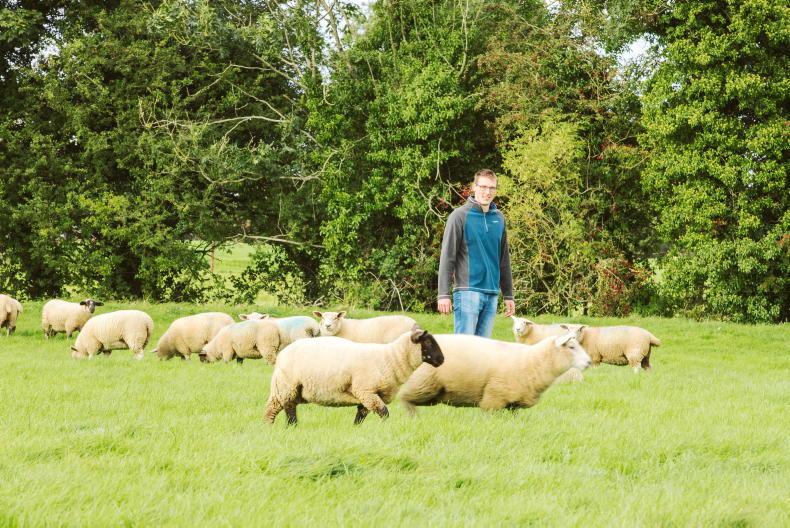
William Clarke pictured with Suffolk cross and Belclare cross ewe lambs which will be joined with rams this season.
Potential replacements are identified at birth from ewes exhibiting good mothering skills. A higher number of ewe lambs than is required as replacements is selected at weaning from this cohort of lambs and retained up until joining with rams. This provides an opportunity to draft off lambs which do not subsequently perform as desired.
Nutrition
There is big emphasis placed on nutrition. Sheep are grazed in a rotational system with big grazing groups rising to as high as 300 mature ewes and twin lambs ideal for quickly grazing out 10-acre paddocks. Lambs are finished off grass up until the start or middle of September and at this stage concentrates are introduced in troughs for a period before ad-lib feeders are introduced to finish the last of the lambs.

Charollais cross lambs which have been drafted for slaughter.
Ewes are housed once grass reserves are depleted with the first paddocks earmarked for spring grazing closed around 15 to 20 October. Housing is normal in late December and ewes are offered top-quality haylage of 74% to 75% DMD. This also reduces the late pregnancy concentrate feed requirement.
Health
There is a preventative health programme in place while adequate nutrition is also focused on to prevent nutrition-related ailments. Vaccines are administered for pasteurella & clostridial diseases, enzootic abortion and toxoplasmosis while regular footbathing with zinc sulphate generally keeps on top of lameness issues.
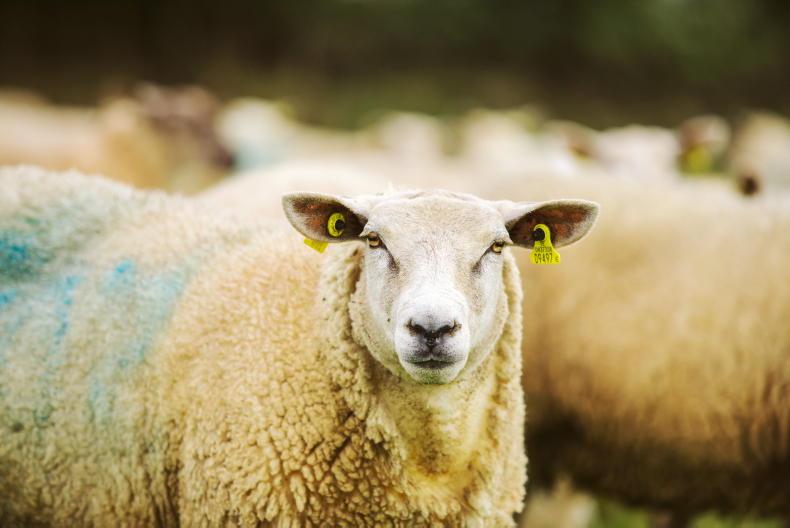
A typical Belclare cross ewe on the Clarke farm. Ewes are is derived from a crossbreeding programme using Belclare and Suffolk genetics.
Outside of this, normal treatments are administered for worms, fluke and external parasites while William comments that a notable switch which has resolved some joint ill issues is a switch from iodine to chlorohexidine for treating navels in newborn lambs.
Hooked on breeding & quality sheep in Tyrone
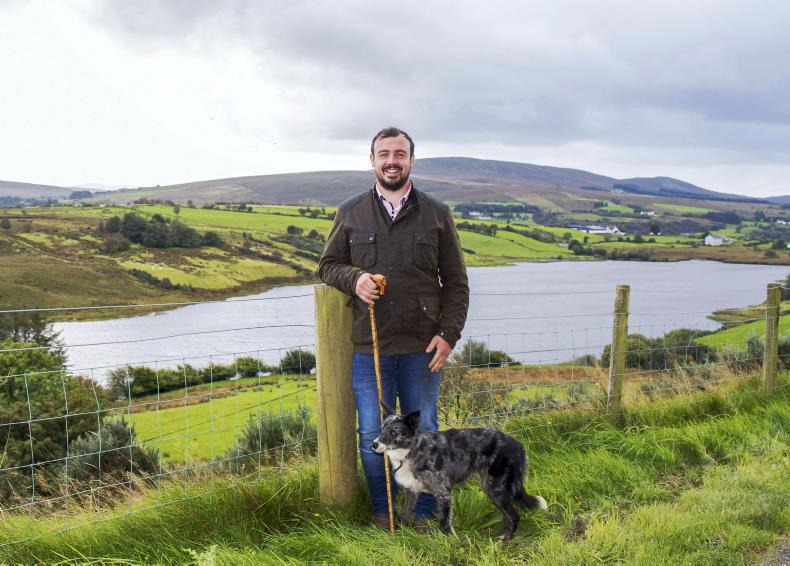
Cathal Harkin and his sheepdog Jess overlooking Loughash lake in Co Tyrone.
Cathal Harkin and his father Charlie run the Rock Blackface (Loughash) flock in Loughash, Dunamanagh, Strabane, Co Tyrone. The farm is run with help from all members of the family.
The large-scale enterprise extends to 1,500 ewes with most of these comprising Lanark-type Scottish Blackface ewes along with about 200 Mule and crossbred ewes and a small flock of pedigree Texel sheep.
Management
The farm area extends to about 1,000 acres (405ha) of owned/rented land and is a mixture of hill grazing with varying levels of productivity and good-quality upland/lowland ground. There is a strong focus in breeding rams and female replacements with in the region of 60 to 70 tups (rams) sold annually along with a few hundred ewe lambs, ewe hoggets and aged breeding ewes.
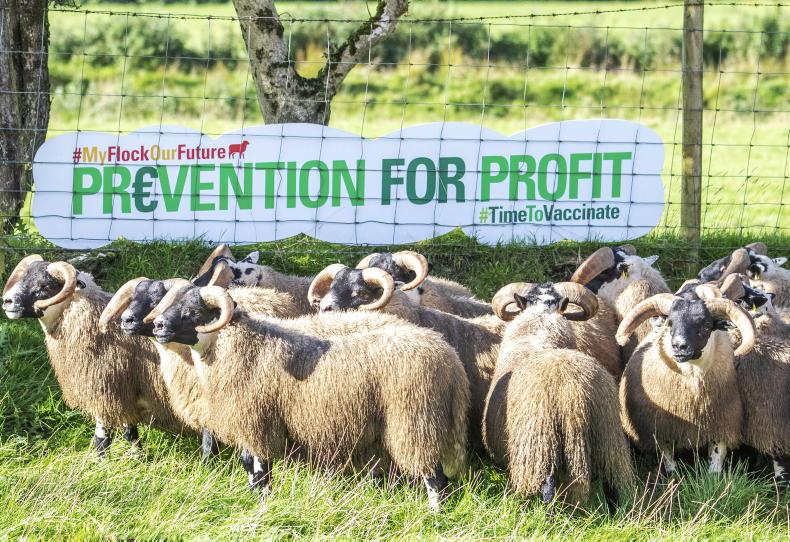
Lanark ram lambs which have been selected for sale or retaining for use on the flock in this year's breeding season.
Male progeny are sold as stores along with female progeny that do not make the grade for breeding. The flock utilises electronic identification and tagging lambs at birth to monitor breeding lines.
Breeding
Cathal says the focus in the flock is to try to bring about improvement on an annual basis by sourcing genetics that will add desired genetics in to the breeding mix. The Texel flock lambs in March with Mule/crossbred ewes shortly after and Blackface ewes from the start to mid-April onwards. The highest-value ewes and recipient ewes are lambed indoors to allow greater supervision and provide protection from grey crows which are highlighted as being a constant threat.
Nutrition
Close attention is placed on ewe body condition across all stages of the production cycle. Breeding lines are also closely followed to ensure that incorporating desired traits does not imbalance the ewe’s ability to look after herself.
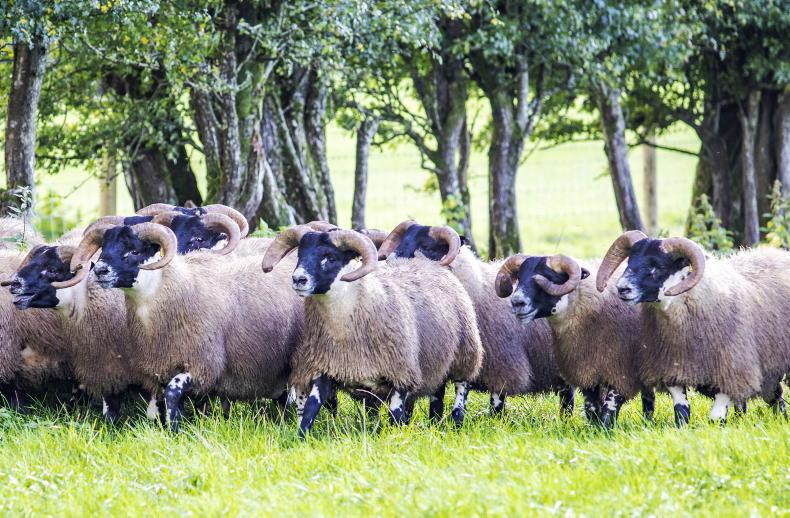
The Harkin's system is focused on producing top-quality rams and female replacements for sale along while animals not meeting the grade are ran comercially.
All ewes are outwintered and supplementation is provided when required via feeding sugar beet nuts and fodder beet. Ewes and lambs are fed cob nuts if required post-lambing.
Ram lambs earmarked for sale are offered concentrate supplementation in troughs twice daily, with Cathal commenting that they do not feed ad lib as they want to avoid rams getting accustomed to such a feeding system and losing their natural vigour.
Health
There is an extensive health protocol in place. Replacements are vaccinated for enzootic abortion and toxoplasmosis while all sheep are also on a pasteurella and clostridial disease vaccination programme. The lameness vaccine is administered to hogget ewes, with Cathal remarking that the flock generally doesn’t have an issue with lameness and normal instances of scald are addressed by footbathing.
Ewes are plunge-dipped annually while dosing for fluke and worms takes place as required, with faecal egg samples used as an aid for worm control. The mineral status is also closely followed with cobalt, copper and selenium deficiencies identified where sheep are grazing on certain areas.
William Clarke and his father David run a flock of approximately 570 mid-season lambing ewes and ewe lambs in Hillsire, Ardrums, Rathmoylan, Co Meath. The farm, which extends to 200 acres (81ha), also operates a dairy-beef enterprise where 50 Angus heifers are brought in at about three to four weeks of age and finished at 18 to 20 months of age on average.
Management
The farm achieved a fine output figure in 2021 of 1.65 lambs weaned from about 435 ewes and 135 ewe lambs joined with rams in 2020. The platform for strong performance is built on close attention to detail across all the key production parameters.
Mature ewes scanned 2.12 lambs per ewe joined in 2021 while ewe lambs scanned 1.39 lambs per ewe joined and a litter size of 1.78 lambs with the barren rate of 20% running ahead of the norm of 9% to 10%. The ram effect is used to condense the lambing period.
Breeding
The high level of output is underpinned by management and nutrition exploiting prolific genetics. A criss-cross breeding programme using Belclare and Suffolk rams is practised, with the flock currently veering on the side of 60% of breeding ewes being sired by a Belclare ram. Charollais rams with good terminal traits are joined with ewes not used to breed replacements.

William Clarke pictured with Suffolk cross and Belclare cross ewe lambs which will be joined with rams this season.
Potential replacements are identified at birth from ewes exhibiting good mothering skills. A higher number of ewe lambs than is required as replacements is selected at weaning from this cohort of lambs and retained up until joining with rams. This provides an opportunity to draft off lambs which do not subsequently perform as desired.
Nutrition
There is big emphasis placed on nutrition. Sheep are grazed in a rotational system with big grazing groups rising to as high as 300 mature ewes and twin lambs ideal for quickly grazing out 10-acre paddocks. Lambs are finished off grass up until the start or middle of September and at this stage concentrates are introduced in troughs for a period before ad-lib feeders are introduced to finish the last of the lambs.

Charollais cross lambs which have been drafted for slaughter.
Ewes are housed once grass reserves are depleted with the first paddocks earmarked for spring grazing closed around 15 to 20 October. Housing is normal in late December and ewes are offered top-quality haylage of 74% to 75% DMD. This also reduces the late pregnancy concentrate feed requirement.
Health
There is a preventative health programme in place while adequate nutrition is also focused on to prevent nutrition-related ailments. Vaccines are administered for pasteurella & clostridial diseases, enzootic abortion and toxoplasmosis while regular footbathing with zinc sulphate generally keeps on top of lameness issues.

A typical Belclare cross ewe on the Clarke farm. Ewes are is derived from a crossbreeding programme using Belclare and Suffolk genetics.
Outside of this, normal treatments are administered for worms, fluke and external parasites while William comments that a notable switch which has resolved some joint ill issues is a switch from iodine to chlorohexidine for treating navels in newborn lambs.
Hooked on breeding & quality sheep in Tyrone

Cathal Harkin and his sheepdog Jess overlooking Loughash lake in Co Tyrone.
Cathal Harkin and his father Charlie run the Rock Blackface (Loughash) flock in Loughash, Dunamanagh, Strabane, Co Tyrone. The farm is run with help from all members of the family.
The large-scale enterprise extends to 1,500 ewes with most of these comprising Lanark-type Scottish Blackface ewes along with about 200 Mule and crossbred ewes and a small flock of pedigree Texel sheep.
Management
The farm area extends to about 1,000 acres (405ha) of owned/rented land and is a mixture of hill grazing with varying levels of productivity and good-quality upland/lowland ground. There is a strong focus in breeding rams and female replacements with in the region of 60 to 70 tups (rams) sold annually along with a few hundred ewe lambs, ewe hoggets and aged breeding ewes.

Lanark ram lambs which have been selected for sale or retaining for use on the flock in this year's breeding season.
Male progeny are sold as stores along with female progeny that do not make the grade for breeding. The flock utilises electronic identification and tagging lambs at birth to monitor breeding lines.
Breeding
Cathal says the focus in the flock is to try to bring about improvement on an annual basis by sourcing genetics that will add desired genetics in to the breeding mix. The Texel flock lambs in March with Mule/crossbred ewes shortly after and Blackface ewes from the start to mid-April onwards. The highest-value ewes and recipient ewes are lambed indoors to allow greater supervision and provide protection from grey crows which are highlighted as being a constant threat.
Nutrition
Close attention is placed on ewe body condition across all stages of the production cycle. Breeding lines are also closely followed to ensure that incorporating desired traits does not imbalance the ewe’s ability to look after herself.

The Harkin's system is focused on producing top-quality rams and female replacements for sale along while animals not meeting the grade are ran comercially.
All ewes are outwintered and supplementation is provided when required via feeding sugar beet nuts and fodder beet. Ewes and lambs are fed cob nuts if required post-lambing.
Ram lambs earmarked for sale are offered concentrate supplementation in troughs twice daily, with Cathal commenting that they do not feed ad lib as they want to avoid rams getting accustomed to such a feeding system and losing their natural vigour.
Health
There is an extensive health protocol in place. Replacements are vaccinated for enzootic abortion and toxoplasmosis while all sheep are also on a pasteurella and clostridial disease vaccination programme. The lameness vaccine is administered to hogget ewes, with Cathal remarking that the flock generally doesn’t have an issue with lameness and normal instances of scald are addressed by footbathing.
Ewes are plunge-dipped annually while dosing for fluke and worms takes place as required, with faecal egg samples used as an aid for worm control. The mineral status is also closely followed with cobalt, copper and selenium deficiencies identified where sheep are grazing on certain areas.












 This is a subscriber-only article
This is a subscriber-only article





